|
Step Right Up and Try Your Luck
QUESTION:
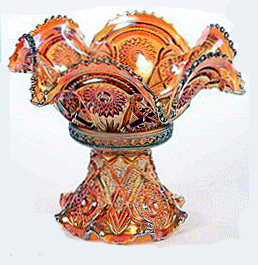 I
just inherited my mother’s collection of carnival glass. I always
admired it while growing up, but she never really told me much about it.
Now that I have it, I’d like to continue collecting, but I have no idea
where to begin. Can you give me some background on carnival glass and
also some tips on growing and maintaining my mother’s collection? I
just inherited my mother’s collection of carnival glass. I always
admired it while growing up, but she never really told me much about it.
Now that I have it, I’d like to continue collecting, but I have no idea
where to begin. Can you give me some background on carnival glass and
also some tips on growing and maintaining my mother’s collection?
Thanks,
Irene
______________________________________________________
ANSWER:
Carnival Glass is pressed
glass—glass that has been formed by being pressed into a mold while
in a hot molten form—that has had an iridescent coating applied. As
it cools, it takes on the shape and detail of the mold. Once removed
from the mold, and while still somewhat hot, the glassmaker sprays
it with metallic salts in liquid form which gives it an
"oil-on-water" multicolor appearance. He then refires the piece.
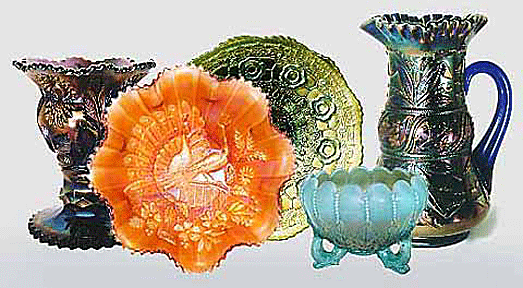
The Fenton Glass of Williamston, West Virginia, first produced
carnival glass, which it called "iridescent ware," in 1907. The
company called its first line Iridill and labeled it "Venetian Art."
They wanted to mass-produce a product that could compete with the
expensive, iridescent art glass made by Tiffany and Steuben. Though
half a dozen companies, including Northwood, Imperial, Millersburg,
Westmoreland, Dugan, and Cambridge, originally made it, Fenton did
so longer than any of the others.
Competition became so fierce between makers that new patterns
appeared regularly, so each company ended up making a wide range of
patterns of most types adding up to a panoply of choice.
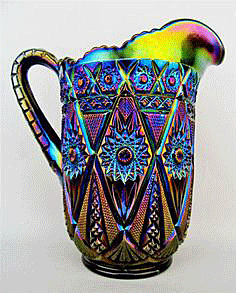 Its
eye-catching multicolor shimmer seems to change colors when viewed
at different angles. Over the years, carnival glass has been dubbed
"Taffeta," "Cinderella," and "Poor Man's Tiffany," as it gave the
average housewife the ability to adorn her home with fancy vases and
decorative bowls a prices she could afford. Its
eye-catching multicolor shimmer seems to change colors when viewed
at different angles. Over the years, carnival glass has been dubbed
"Taffeta," "Cinderella," and "Poor Man's Tiffany," as it gave the
average housewife the ability to adorn her home with fancy vases and
decorative bowls a prices she could afford.
But this new type of glass didn’t catch on with the public the way
Fenton had hoped, especially since they tried pricing it higher than
their regular pieces without the carnival finish. Unfortunately,
most consumers didn't see carnival glass as quality glass and
refused to pay higher prices for it. Other glass manufacturers soon
began making carnival glass using the same iridization techniques.
This overloaded the market and soon prices plummeted. To get rid of
their excess inventory, carnival glass makers at first began giving
it away to carnival owners to use as prizes, but later sold sample
pieces to them in hopes that winners could then purchase additional
items in the same or a similar pattern. Together all the
manufacturers produced over 2,000 different patterns.
This new market for carnival glass was a boon for Fenton, which
produced iridescent ware in 150 patterns up until the late 1920s.
Carnival glass sold for pennies at five-and-dime stores, and
businesses could buy it wholesale at minimal cost. This allowed
movie theaters and grocery stores to give it away as premiums. For
example, Imperial Glass struck lucrative deals with companies like
Woolsworth's and Quaker Oats.
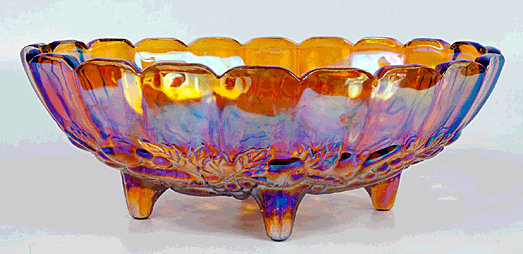
Fenton's earliest patterns included Waterlily and Cattails, Vintage,
Butterfly and Berries, Peacock Tail, Ribbon Tie, Wreath of Roses,
Thistle, and Diamond and Rib. Among Northwood's first glass patterns
were Waterlily and Cattails, Cherry and Cable, and Valentine, but
Grape and Cable became their most popular. Millersburg collectors
look for Hobstar and Feather, Blackberry Wreath, and Rays and
Ribbons.
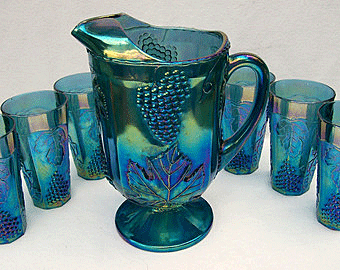 Collectors
call the most popular color of carnival glass “marigold,” although
the companies, themselves, didn’t call it that. Marigold has a clear
glass base and is the most easily recognizable carnival color. The
final surface colors of marigold are mostly a bright orange-gold
turning perhaps to copper with small areas showing rainbow or
'oil-slick' highlights. The highlights appear mostly on ridges in
the pattern and vary in strength according to the light. Collectors
call the most popular color of carnival glass “marigold,” although
the companies, themselves, didn’t call it that. Marigold has a clear
glass base and is the most easily recognizable carnival color. The
final surface colors of marigold are mostly a bright orange-gold
turning perhaps to copper with small areas showing rainbow or
'oil-slick' highlights. The highlights appear mostly on ridges in
the pattern and vary in strength according to the light.
Carnival glass is highly collectible. Prices vary widely, with some
pieces worth very little, while other, rare items command thousands
of dollars.
However, identifying carnival glass can be a challenge. It involves
matching patterns, colors, sheen, edges, and thickness from
information contained in old manufacturer's trade catalogs, other
known examples, or other reference material. Many manufacturers
didn’t include a maker's mark on their product, and some did for
only part of the time they produced the glass. Since many
manufacturers produced close copies of their rivals' popular
patterns, carnival glass identification can be difficult even for an
expert.
By 1925, carnival glass started to fall out of favor with Americans,
and many U.S. glass companies quit producing it during the Great
Depression.
<
Back to Readers Ask Archives
Next Article > |
